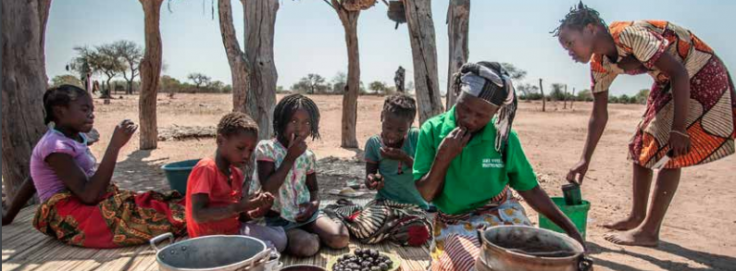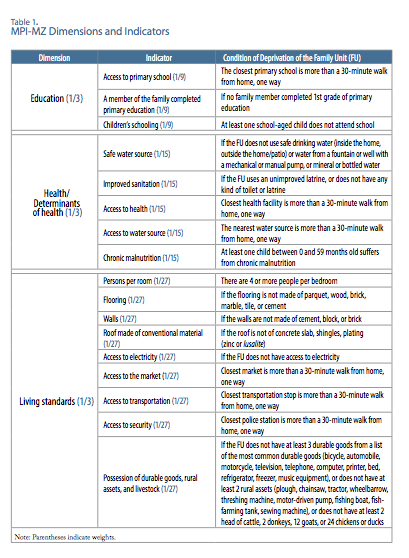
Search
Mozambique: The First African Country with an Official National MPI

Until a few years ago, the estimation of poverty in Mozambique was based on personal consumption. Over time, however, the concept of poverty and how it is measured has evolved. According to Finorio Castigo, specialist at the Directorate of Economic and Financial Studies (DEEF) at the Ministry of Economy and Finance, this change is reflected, for example, in the Action Plan for the Reduction of Absolute Poverty (PARPA I).
The plan shifted from considering the material dimensions of poverty only, with the resulting measure being based on the cost of basic needs, to a broader concept defined as ‘the incapacity of individuals, families, and communities, due to inability or lack of opportunity, to have access to minimum conditions, in accordance with basic norms of society’ (PARPA II). For Castigo, this definition ‘requires the introduction of a series of indicators tied not only to capabilities, but also to opportunities in education, health/nutrition, and asset ownership’.
The first evaluation of poverty and well-being in Mozambique took place in 1996/97 and had a purely monetary focus. The latest, conducted in 2014/15 by the Ministry of Economy and Finance, offers not only estimations of multidimensional poverty for a given year but also its evolution over time. This is possible thanks to the publication of two multidimensional measures of poverty. One compares poverty over time (see box), and the other, more thorough, measure takes into consideration the same dimensions as the global MPI, but also includes a group of additional indicators based on the information available in Mozambique. This information was taken from the most recent household budget survey (IOF 2014/15) which, according to Vincenzo Salvucci, UNU-WIDER researcher and adviser at DEEF, delivers ‘more comprehensive data, and contains information about a broader range of indicators regarding the complex state of well-being in the country’.
Toward a National MPI
With a broader concept of poverty, it was necessary to find a method to measure it that would be compatible with its multidimensionality. The Alkire-Foster method was selected because it was one of the most widely used worldwide among measures of its kind, and it could also include a broad range of indicators.
The next task was how to select the dimensions and indicators for the MPI for Mozambique (MPI-MZ). Three criteria were established to this end. The first was to define the relevance of each dimension and indicator in relation to well-being, taking into consideration the existing literature and other countries’ experiences.
The second criterion was the result of five workshops on multidimensional poverty that were organised by DEEF. These workshops took place in 2015 in collaboration with the United Nations Development Programme (UNDP) and the United Nations Children’s Funds (UNICEF) in Mozambique – in the capital city of Maputo (two workshops), in the northern region of Cabo Delgado, in Zambézia (located in the central region), and in the southern region of Inhambane. The goal of these workshops was to identify the dimensions and indicators that reflect the characteristics of poverty and well-being for Mozambicans.
In rural areas, 70% of the population are in a situation of multidimensional poverty, while in urban areas it is 17%
The third criterion was the availability of information. Concurrently with the workshops, DEEF assessed the desired and/or existing dimensions and indicators that would reflect non-monetary aspects of poverty in the four databases of the household budget surveys: IAF 1996/97, IAF 2002/03, IOF 2008/09 and IOF 2014/15. The information to create the historical MPI was based on these surveys, and the IOF 2014/15 was used to create the MPI-MZ.
This process identified 17 indicators, grouped into three dimensions – education, health and determinants of health, and living standards – which are the components of the 2014/15 MPI-MZ (see Table 1). Given the importance of each, the decision was made to give equal weight to each dimension. All of the indicators for each dimension were also given equal weights.
Analysis of the 2014/15 MPI-MZ indicates that 53% of the population is multidimensionally poor. There is a great difference between rural and urban areas. In rural areas, 70% of the population are in a situation of multidimensional poverty, while in urban areas it is 17%. Meanwhile, the south of the country has substantially lower levels of poverty (18%) than the central zone (62%) and the north (67%).
Uses
The MPI-MZ will be used by the government of Mozambique in a variety of ways. According to Salvucci, ‘This index will become one of the most important standards for determining the amount of transfers from the central government to the provinces and districts’.
It will also be taken into account when assigning resources for the sectors where the population has the greatest deprivations. Salvucci indicates that ‘investment in policies and provision of public services aimed at areas with more deprivations is becoming ever more important, from the perspectives of both well-being and political economy. Achieving inclusive growth appears to be the main public policy challenge that Mozambique faces in its economic and social development in the coming decades’.
Lastly, the MPI-MZ will serve as the basis for evaluating the evolution and trends of multidimensional poverty in future household budget surveys. ‘The MPI can help with the design of projects that will contribute to the improvement of people’s living conditions, and assessment over time also is also useful to monitor programmes’ impact’, Castigo states.
Box: Mozambique’s Historical MPI
Mozambique launched its national MPI in 2017, with the goal of complementing the existing measures of monetary poverty and obtaining more comprehensive information about this issue in order to implement more efficient public policies. The national MPI made extensive use of the data available in the 2014/15 Household Budget Survey (IAF/IOF is its acronym in Portuguese). Various indicators incorporated in the measure were not available in the previous rounds of the survey, however, and therefore monitoring over time was not possible. A historical MPI was created to address this limitation. This is a simplified index compared to the official one, but it allows for an evaluation of data dating back to 1996/97.
The historical MPI consists of four dimensions (education, determinants of health, living conditions, and durable goods) and six indicators, chosen based on information that was continuously available in the IAF/IOF surveys conducted in 1996/97, 2002/03, 2008/09, and 2014/15. All of the indicators are given equal weight in this measure. Households with deprivations in at least four of the six indicators are considered multidimensionally poor.
The results obtained with this simplified historical MPI demonstrate a great reduction in the proportion of the population living in multidimensional poverty over time, from 86% in 1996/97 to 55% in 2014/15. Significant differences are also evident between rural and urban areas, as well as on a regional level, where the south of the country shows much lower levels of multidimensional poverty than the centre and the north.
With respect to the indicators, the results show a reduction in the levels of deprivation over time in all of them, with differences in the speed of that reduction between the analysed indicators. Access to education and access to safe drinking water are the indicators that have most improved among the population. Nonetheless, according to the document ‘Poverty and Well-Being in Mozambique: Fourth National Poverty Assessment‘, a large portion of the population still suffers deprivations with regard to housing conditions, such as access to safe sanitation, electricity, and durable goods – especially in rural areas.
Original in Spanish. Translated by Kristin S. Fisher.
Read 5th Dimensions Issue here.

















